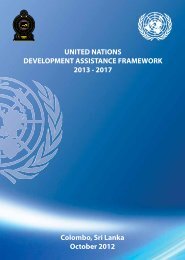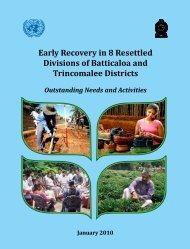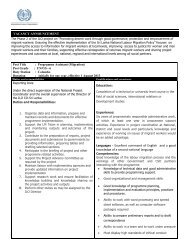Sri Lanka Human Development Report 2012.pdf
Sri Lanka Human Development Report 2012.pdf
Sri Lanka Human Development Report 2012.pdf
Create successful ePaper yourself
Turn your PDF publications into a flip-book with our unique Google optimized e-Paper software.
CHAPTER<br />
6<br />
Bridging<br />
Governance Gaps: State Capacity and People’s Participation<br />
As <strong>Sri</strong> <strong>Lanka</strong> works to sustain peace, accelerate growth<br />
and ensure inclusiveness in the post-conflict era, citizens<br />
need confidence in governance structures. Some people<br />
may still contend that better and inclusive governance<br />
is a cosmetic element in the process of growth, but this<br />
report argues that it is an intrinsic component of human<br />
development. Good governance strengthens employment<br />
creation through enterprise growth, better provision<br />
of government services and inclusive participation in<br />
governance processes.<br />
The previous chapters drew attention to a number of human<br />
development challenges and the critical public policy<br />
choices to meet them. This chapter discusses elements of<br />
governance important to current development challenges,<br />
with a focus on an environment enabling inclusive growth.<br />
For more people to seize new economic opportunities,<br />
education and skills must be improved, productivity and<br />
efficiency boosted, and innovation and creativity spurred.<br />
These challenges are not merely about resources. They<br />
also underscore the centrality of the Government in the<br />
complex choices that influence private economic activity<br />
across the country, a key element for accelerating growth<br />
and sharing it more equitably.<br />
One important caveat is that the lack of data on various<br />
governance dimensions severely limits any extended<br />
quantitative analysis. This constraint is especially binding<br />
when it comes to spatial disparities. With that in mind, the<br />
report considers the following dimensions: taxation and<br />
state capacity to bridge human development gaps, along<br />
with implications for governance and accountability; the<br />
creation of an enabling environment for business; stronger<br />
local governance and people’s participation.<br />
The State Capacity to Finance <strong>Development</strong><br />
The <strong>Sri</strong> <strong>Lanka</strong>n state continues to be the primary provider<br />
of social services, such as education and health. Funding<br />
depends heavily upon government finance through tax<br />
revenues. Strengthening the financial capacity of the state,<br />
and thus its ability to provide these services, is vital.<br />
The public education system remains the predominant<br />
provider of general education, as discussed in Chapter 4.<br />
Strong public investment has enabled <strong>Sri</strong> <strong>Lanka</strong> to attain<br />
high levels of human development. Yet wide disparities<br />
exist in access to, and the quality of, education across<br />
the country, particularly at higher levels. And public<br />
investment in education has declined steadily over time,<br />
remaining low compared to similar countries.<br />
In the health sector, similar issues prevail. As discussed in<br />
Chapter 3, investment in health, both public and private,<br />
is low. Out-of-pocket expenditure by citizens is high and<br />
rising, which has negative implications for equitable access<br />
to care. Meeting increasing and changing health demands<br />
requires greater state capacity.<br />
To address education and health needs, improving tax<br />
revenue becomes ever more important, particularly as<br />
<strong>Sri</strong> <strong>Lanka</strong> moves towards upper middle-income country<br />
status and has less access to concessionary aid. However,<br />
it has not raised tax revenues in line with economic<br />
growth in recent decades. The fiscal system, on the other<br />
hand, has been changed by several ad hoc tax measures<br />
that have excessively complicated the tax system. It is<br />
uncertain whether these complexities are related to weak<br />
performance in raising revenues.<br />
Tax revenue as a share of GDP dropped to around 15<br />
percent during 2003-2008, compared to about 19 percent<br />
before 1995. The benchmark tax-GDP ratio for a lowincome<br />
country is 18 percent, and is 25 percent for a<br />
middle-income country. 293 <strong>Sri</strong> <strong>Lanka</strong>’s tax ratio was just<br />
12.4 percent in 2011, having declined from a peak of 24<br />
percent in 1987 (Figure 6.1). Its tax-GDP ratio compares<br />
poorly with those of Ghana, Malaysia, Singapore, South<br />
Africa, Thailand and Vietnam, although it is better than<br />
for South Asian neighbours such as Bangladesh, India and<br />
Pakistan, and marginally better than for Indonesia and the<br />
Philippines (Figure 6.2).<br />
sri lanka <strong>Human</strong> <strong>Development</strong> report 2012 101






